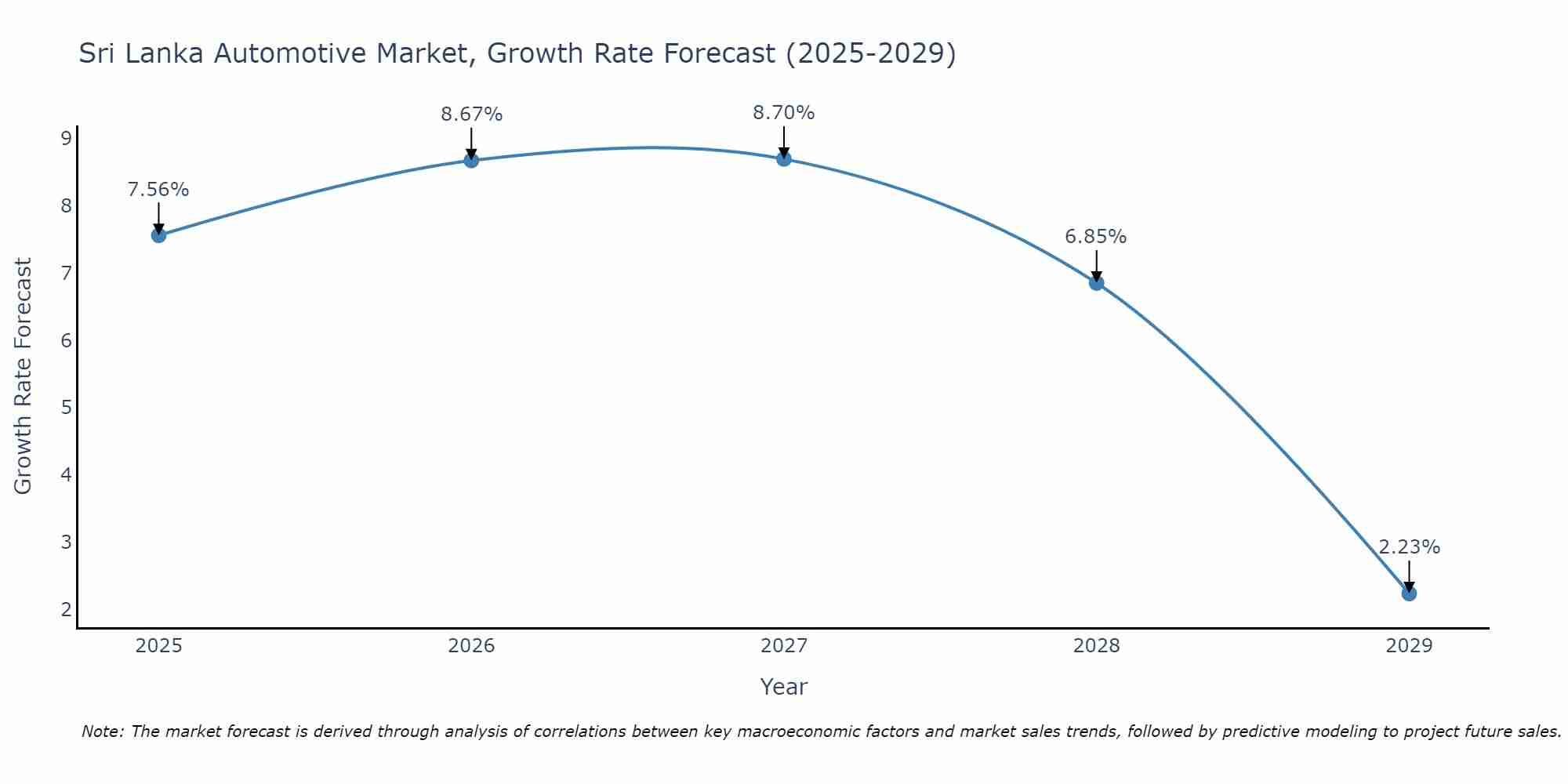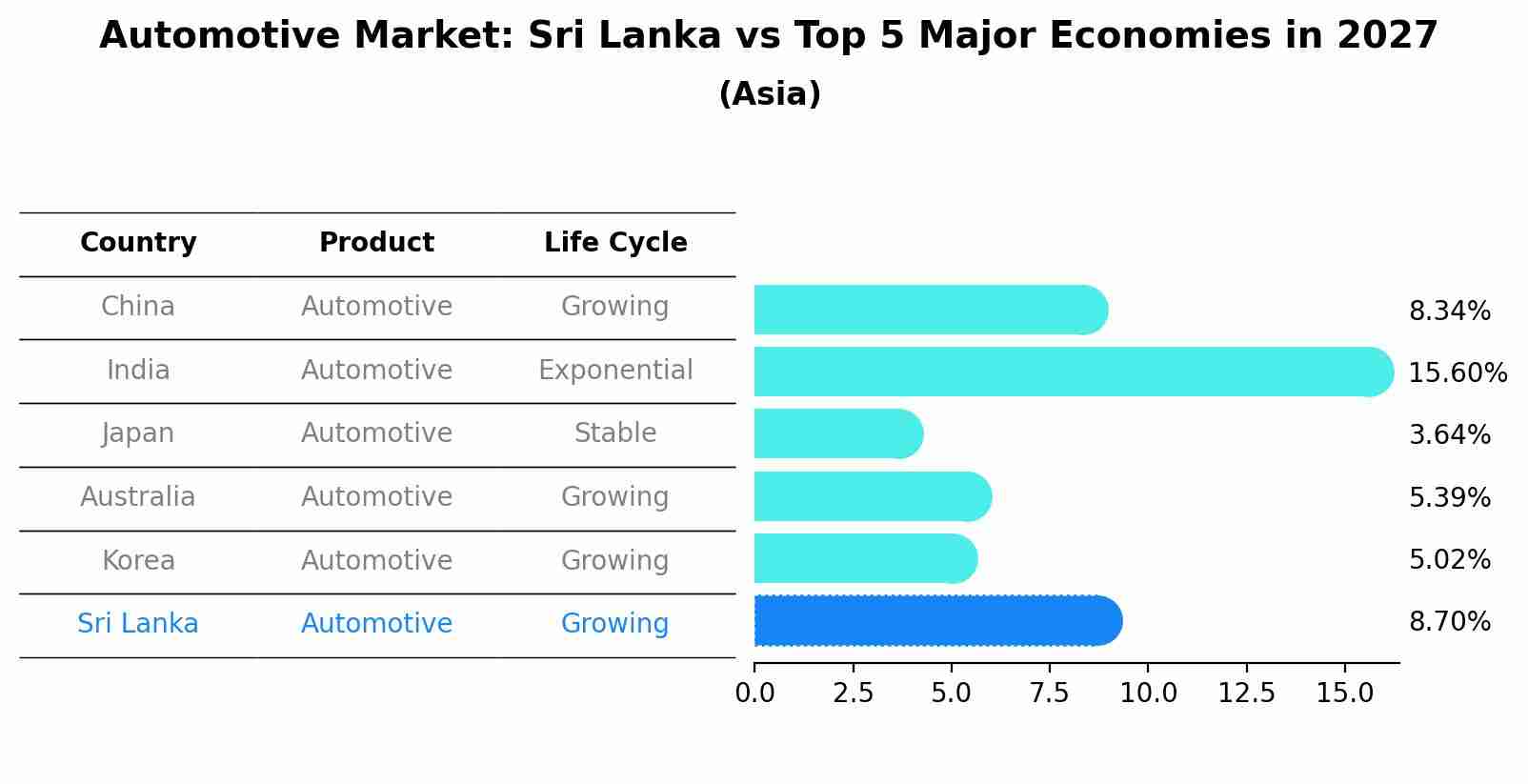Sri Lanka Automotive Market Outlook | Revenue, Forecast, Industry, Companies, Growth, Trends, Analysis, Value, Size, COVID-19 IMPACT & Share
| Product Code: ETC431787 | Publication Date: Oct 2022 | Updated Date: Jul 2025 | Product Type: Market Research Report | |
| Publisher: 6Wresearch | Author: Bhawna Singh | No. of Pages: 75 | No. of Figures: 35 | No. of Tables: 20 |
Sri Lanka Automotive Market Size Growth Rate
The Sri Lanka Automotive Market is projected to witness mixed growth rate patterns during 2025 to 2029. The growth rate begins at 7.56% in 2025, climbs to a high of 8.70% in 2027, and moderates to 2.23% by 2029.

Automotive Market: Sri Lanka vs Top 5 Major Economies in 2027 (Asia)
By 2027, the Automotive market in Sri Lanka is anticipated to reach a growth rate of 8.70%, as part of an increasingly competitive Asia region, where China remains at the forefront, supported by India, Japan, Australia and South Korea, driving innovations and market adoption across sectors.

Sri Lanka Automotive Market Synopsis
The Sri Lankan automotive market has been experiencing steady growth in recent years, driven by factors such as increasing disposable income, urbanization, and improving infrastructure. The market is primarily dominated by Japanese brands such as Toyota, Honda, and Nissan, with a growing demand for compact cars and SUVs. The government`s initiatives to promote electric vehicles and reduce import duties on hybrid vehicles have also contributed to the market`s expansion. However, challenges such as high import taxes, limited financing options, and fluctuating exchange rates have impacted the market`s growth potential. Overall, the Sri Lankan automotive market presents opportunities for both domestic and international manufacturers to tap into the growing consumer demand for vehicles in the country.
Sri Lanka Automotive Market Trends
The Sri Lankan automotive market is experiencing a shift towards more eco-friendly vehicles, with increasing demand for hybrid and electric vehicles. This trend is driven by growing environmental concerns and government initiatives to promote sustainable transportation options. Additionally, there is a rising preference for compact and fuel-efficient vehicles due to the country`s traffic congestion and high fuel prices. The market is also witnessing a surge in demand for SUVs and crossovers, reflecting changing consumer preferences towards larger and versatile vehicles. Furthermore, the adoption of advanced safety features and connectivity technologies in vehicles is gaining traction among consumers in Sri Lanka, indicating a shift towards more advanced and technologically equipped vehicles in the market.
Sri Lanka Automotive Market Challenges
The Sri Lankan Automotive Market faces several challenges, including high import taxes and duties on vehicles, which drive up prices for consumers. Additionally, limited infrastructure and road quality in certain regions can hinder the growth of the market. The fluctuation of the Sri Lankan currency against major currencies also impacts the affordability of vehicles, leading to uncertainty for both consumers and industry players. Furthermore, the lack of stringent regulations and enforcement in terms of vehicle emissions and safety standards pose challenges for the industry in meeting international benchmarks. Overall, these factors contribute to a challenging operating environment for automotive companies in Sri Lanka, requiring strategic planning and adaptation to navigate the market effectively.
Sri Lanka Automotive Market Investment Opportunities
The Sri Lanka automotive market presents several investment opportunities, driven by factors such as increasing disposable income, urbanization, and infrastructure development. One key opportunity lies in the growth of electric vehicles (EVs) as the government aims to promote sustainable transportation solutions and reduce carbon emissions. Investing in EV charging infrastructure, manufacturing or distribution of EVs, and related technology development could be lucrative. Additionally, there is a demand for affordable and fuel-efficient vehicles in Sri Lanka, offering opportunities for manufacturers to introduce compact cars or two-wheelers tailored to the local market. Partnering with local dealerships or launching innovative financing solutions to make vehicles more accessible to a wider consumer base are also potential avenues for investment in the Sri Lankan automotive market.
Jordan Agar Market Government Policies
Government policies related to the Sri Lanka Automotive Market include the reduction of import tariffs on electric vehicles to promote their adoption and reduce emissions. Additionally, there are tax incentives and subsidies in place to encourage the manufacturing and assembly of vehicles within the country. The government also imposes strict emission regulations to control pollution levels and promote environmentally friendly vehicles. Furthermore, there are regulations in place to ensure vehicle safety standards are met, including mandatory vehicle inspections. Overall, the government aims to modernize the automotive sector, promote sustainable transportation solutions, and boost the local automotive industry through a combination of incentives, regulations, and support mechanisms.
Sri Lanka Automotive Market Future Outlook
The future outlook for the Sri Lanka Automotive Market is positive, with expected growth driven by increasing disposable incomes, improving infrastructure, and a rising demand for personal vehicles. The government`s focus on promoting electric vehicles and reducing import tariffs on hybrid vehicles is also likely to boost the market. Additionally, the growing popularity of ride-sharing services is expected to drive demand for vehicles in the commercial sector. However, challenges such as fluctuating exchange rates, high taxes, and stringent emission standards could impact market growth. Overall, the Sri Lanka Automotive Market is poised for expansion, offering opportunities for both domestic and international automotive manufacturers to capitalize on the country`s evolving transportation needs.
Key Highlights of the Report:
- Sri Lanka Automotive Market Outlook
- Market Size of Sri Lanka Automotive Market, 2021
- Forecast of Sri Lanka Automotive Market, 2031
- Historical Data and Forecast of Sri Lanka Automotive Revenues & Volume for the Period 2018 - 2031
- Sri Lanka Automotive Market Trend Evolution
- Sri Lanka Automotive Market Drivers and Challenges
- Sri Lanka Automotive Price Trends
- Sri Lanka Automotive Porter's Five Forces
- Sri Lanka Automotive Industry Life Cycle
- Historical Data and Forecast of Sri Lanka Automotive Market Revenues & Volume By Product Type for the Period 2018 - 2031
- Historical Data and Forecast of Sri Lanka Automotive Market Revenues & Volume By Electric for the Period 2018 - 2031
- Historical Data and Forecast of Sri Lanka Automotive Market Revenues & Volume By Hybrid Electric for the Period 2018 - 2031
- Historical Data and Forecast of Sri Lanka Automotive Market Revenues & Volume By Plug-In Hybrid Electric for the Period 2018 - 2031
- Historical Data and Forecast of Sri Lanka Automotive Market Revenues & Volume By Mild Hybrid for the Period 2018 - 2031
- Historical Data and Forecast of Sri Lanka Automotive Market Revenues & Volume By Natural Gas for the Period 2018 - 2031
- Historical Data and Forecast of Sri Lanka Automotive Market Revenues & Volume By Fuel Cell Electric for the Period 2018 - 2031
- Historical Data and Forecast of Sri Lanka Automotive Market Revenues & Volume By Diesel for the Period 2018 - 2031
- Historical Data and Forecast of Sri Lanka Electric Automotive Market Revenues & Volume By Petrol for the Period 2018 - 2031
- Sri Lanka Automotive Import Export Trade Statistics
- Market Opportunity Assessment By Product Type
- Sri Lanka Automotive Top Companies Market Share
- Sri Lanka Automotive Competitive Benchmarking By Technical and Operational Parameters
- Sri Lanka Automotive Company Profiles
- Sri Lanka Automotive Key Strategic Recommendations
Frequently Asked Questions About the Market Study (FAQs):
- Single User License$ 1,995
- Department License$ 2,400
- Site License$ 3,120
- Global License$ 3,795
Search
Thought Leadership and Analyst Meet
Our Clients
Related Reports
- Australia Briquette Market (2025-2031) | Growth, Size, Revenue, Forecast, Analysis, Trends, Value, Share, Industry & Companies
- Vietnam System Integrator Market (2025-2031) | Size, Companies, Analysis, Industry, Value, Forecast, Growth, Trends, Revenue & Share
- ASEAN and Thailand Brain Health Supplements Market (2025-2031) | Strategy, Consumer Insights, Analysis, Investment Trends, Opportunities, Growth, Size, Share, Industry, Revenue, Segments, Value, Segmentation, Supply, Forecast, Restraints, Outlook, Competition, Drivers, Trends, Demand, Pricing Analysis, Competitive, Strategic Insights, Companies, Challenges
- ASEAN Bearings Market (2025-2031) | Strategy, Consumer Insights, Analysis, Investment Trends, Opportunities, Growth, Size, Share, Industry, Revenue, Segments, Value, Segmentation, Supply, Forecast, Restraints, Outlook, Competition, Drivers, Trends, Demand, Pricing Analysis, Competitive, Strategic Insights, Companies, Challenges
- Europe Flooring Market (2025-2031) | Outlook, Share, Industry, Trends, Forecast, Companies, Revenue, Size, Analysis, Growth & Value
- Saudi Arabia Manlift Market (2025-2031) | Outlook, Size, Growth, Trends, Companies, Industry, Revenue, Value, Share, Forecast & Analysis
- Uganda Excavator, Crane, and Wheel Loaders Market (2025-2031) | Strategy, Consumer Insights, Analysis, Investment Trends, Opportunities, Growth, Size, Share, Industry, Revenue, Segments, Value, Segmentation, Supply, Forecast, Restraints, Outlook, Competition, Drivers, Trends, Demand, Pricing Analysis, Competitive, Strategic Insights, Companies, Challenges
- Rwanda Excavator, Crane, and Wheel Loaders Market (2025-2031) | Strategy, Consumer Insights, Analysis, Investment Trends, Opportunities, Growth, Size, Share, Industry, Revenue, Segments, Value, Segmentation, Supply, Forecast, Restraints, Outlook, Competition, Drivers, Trends, Demand, Pricing Analysis, Competitive, Strategic Insights, Companies, Challenges
- Kenya Excavator, Crane, and Wheel Loaders Market (2025-2031) | Strategy, Consumer Insights, Analysis, Investment Trends, Opportunities, Growth, Size, Share, Industry, Revenue, Segments, Value, Segmentation, Supply, Forecast, Restraints, Outlook, Competition, Drivers, Trends, Demand, Pricing Analysis, Competitive, Strategic Insights, Companies, Challenges
- Angola Excavator, Crane, and Wheel Loaders Market (2025-2031) | Strategy, Consumer Insights, Analysis, Investment Trends, Opportunities, Growth, Size, Share, Industry, Revenue, Segments, Value, Segmentation, Supply, Forecast, Restraints, Outlook, Competition, Drivers, Trends, Demand, Pricing Analysis, Competitive, Strategic Insights, Companies, Challenges
Industry Events and Analyst Meet
Whitepaper
- Middle East & Africa Commercial Security Market Click here to view more.
- Middle East & Africa Fire Safety Systems & Equipment Market Click here to view more.
- GCC Drone Market Click here to view more.
- Middle East Lighting Fixture Market Click here to view more.
- GCC Physical & Perimeter Security Market Click here to view more.
6WResearch In News
- Doha a strategic location for EV manufacturing hub: IPA Qatar
- Demand for luxury TVs surging in the GCC, says Samsung
- Empowering Growth: The Thriving Journey of Bangladesh’s Cable Industry
- Demand for luxury TVs surging in the GCC, says Samsung
- Video call with a traditional healer? Once unthinkable, it’s now common in South Africa
- Intelligent Buildings To Smooth GCC’s Path To Net Zero


















